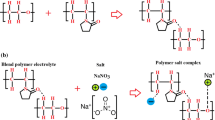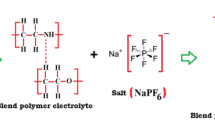Abstract
Classical solution-cast and ultrasonic–microwave-irradiated solution-cast methods have been used for the preparation of solid polymer electrolyte (SPE) films comprising polymer matrix of poly(ethylene oxide) and poly(methyl methacrylate) blend and lithium tetrafluoroborate (LiBF4) ionic salt. These films have been characterized by employing the X-ray diffraction, Fourier transform infrared spectroscopy, dielectric relaxation spectroscopy, and electrochemical analyser. It is observed that the temperature-dependent ionic conductivity of these predominantly amorphous solid ion–dipolar complexes is governed by their dielectric permittivity and the relaxation times of various dynamical processes. The relaxation times and the dc ionic conductivity of these electrolyte materials obey the Arrhenius behaviour, whereas the normalized ac conductivity exhibits the time–temperature superposition scaling. The influence of sample preparation methods on the performance of SPE films and the suitability of these materials for the lithium-ion batteries has been explored by noting the relative changes in their structural, dielectric, electrical, ionic conductivity, and the electrochemical parameters.











Similar content being viewed by others
References
Yue L, Ma J, Zhang J, Zhao J, Dong S, Liu Z, Cui G, Che L (2016) All solid-state polymer electrolytes for high-performance lithium ion batteries. Energy Storage Mater 5:139–164
Arya A, Sharma AL (2017) Insights into the use of polyethylene oxide in energy storage/conversion devices: a critical review. J Phys D Appl Phys 50:443002
Arya A, Sharma AL (2017) Polymer electrolytes for lithium ion batteries: a critical study. Ionics 23:497–540
Xue Z, He D, Xie X (2015) Poly(ethylene oxide)–based electrolytes for lithium-ion batteries. J Mater Chem A 3:19218–19253
Dam T, Tripathy SN, Paluch M, Jena SS, Pradhan DK (2016) Investigations of relaxation dynamics and observation of nearly constant loss phenomena in PEO20–LiCF3SO3–ZrO2 based polymer nano-composite electrolyte. Electrochim Acta 202:147–156
Karmakar A, Ghosh A (2014) Structure and ionic conductivity of ionic liquid embedded PEO–LiCF3SO3 polymer electrolyte. AIP Adv 4:087112
Das S, Ghosh A (2015) Ion conduction and relaxation in PEO–LiTFSI–Al2O3 polymer nanocomposite electrolytes. J Appl Phys 117:174103
Klongkan S, Pumchusak J (2015) Effects of nano alumina and plasticizers on morphology, ionic conductivity, thermal and mechanical properties of PEO-LiCF3SO3 solid polymer electrolyte. Electrochim Acta 161:171–176
Sengwa RJ, Choudhary S (2014) Dielectric properties and fluctuating relaxation processes of poly(methyl methacrylate) based polymeric nanocomposite electrolytes. J Phys Chem Solids 75:765–774
Choudhary S, Sengwa RJ (2013) Effects of preparation methods on structure, ionic conductivity and dielectric relaxation of solid polymeric electrolytes. Mater Chem Phys 142:172–181
Sengwa RJ, Choudhary S (2014) Dielectric relaxation spectroscopy and X–ray diffraction studies of poly(ethylene oxide)–lithium perchlorate electrolytes. Indian J Phys 88:461–470
Polu AR, Rhee H-W, Kim DK (2015) New solid polymer electrolytes (PEO20–LiTDI–SN) for lithium batteries: structural, thermal and ionic conductivity studies. J Mater Sci: Mater Electron 26:8548–8554
Masoud EM, El-Bellihi AA, Bayoumy WA, Mousa MA (2013) Organic–inorganic composite polymer electrolyte based on PEO–LiClO4 and nano-Al2O3 filler for lithium polymer batteries: dielectric and transport properties. J Alloys Compd 575:223–228
Choudhary S, Sengwa RJ (2012) Effects of different anions of lithium salt and MMT nanofiller on ion conduction in melt compounded PEO–LiX–MMT electrolytes. Ionics 18:379–384
Deka M, Kumar A (2013) Dielectric and conductivity studies of 90 MeV O7+ ion irradiated poly(ethylene oxide)/montmorillonite based ion conductor. J Solid State Electrochem 17:977–986
Pradhan DK, Karan NK, Thomas R, Katiyar RS (2014) Coupling of conductivity to the relaxation process in polymer electrolytes. Mater Chem Phys 147:1016–1021
Pal P, Ghosh A (2017) Charge carrier dynamics in PMMA–LiClO4 based polymer electrolytes plasticized with different plasticizers. J Appl Phys 122:015101
Shukla N, Thakur AK (2009) Role of salt concentration on conductivity optimization and structural phase separation in a solid polymer electrolyte based on PMMA–LiClO4. Ionics 15:357–367
Pal P, Ghosh A (2018) Influence of TiO2 nano-particles on charge carrier transport and cell performance of PMMA–LiClO4 based nano-composite electrolytes. Electrochim Acta 260:157–167
Ramesh S, Wen LC (2010) Investigation on the effects of addition of SiO2 nanoparticles on ionic conductivity, FTIR, and thermal properties of nanocomposite PMMA–LiCF3SO3–SiO2. Ionics 16:255–262
Liu J, Sakai VG, Maranas JK (2006) Composition dependence of segmental dynamics of poly(methyl methacrylate) in miscible blends with poly(ethylene oxide). Macromolecules 39:2866–2874
Chen C, Maranas JK (2009) A molecular view of dynamic responses when mixing poly(ethylene oxide) and poly(methyl methacrylate). Macromolecules 42:2795–2805
Shi W, Han CC (2012) Dynamic competition between crystallization and phase separation at the growth interface of a PMMA/PEO blend. Macromolecules 45:336–346
Karim SRA, Sim LH, Chan CH, Ramli H (2015) On thermal and spectroscopic studies of poly(ethylene oxide)/poly(methyl methacrylate) blends with lithium perchlorate. Macromol Symp 354:374–383
Liang B, Tang S, Jiang Q, Chen C, Chen X, Li S, Yan X (2015) Preparation and characterization of PEO–PMMA polymer composite electrolytes doped with nano–Al2O3. Electrochim Acta 169:334–341
Ghellichi M, Qazvini NT, Jafari SH, Khonakdar HA, Farajollahi Y, Scheffler C (2013) Conformational, thermal, and ionic conductivity behavior of PEO in PEO/PMMA miscible blend: investigating the effect of lithium salt. J Appl Polym Sci 129:1868–1874
Dhatarwal P, Sengwa RJ (2017) Dielectric and electrical characterization of (PEO–PMMA)–LiBF4–EC plasticized solid polymer electrolyte films. J Polym Res 24:135
Dhatarwal P, Sengwa RJ, Choudhary S (2017) Effect of intercalated and exfoliated montmorillonite clay on the structural, dielectric and electrical properties of plasticized nanocomposite solid polymer electrolytes. Comp Comm 5:1–7
Sengwa RJ, Dhatarwal P, Choudhary S (2014) Role of preparation methods on the structural and dielectric properties of plasticized polymer blend electrolytes: correlation between ionic conductivity and dielectric parameters. Electrochim Acta 142:359–370
Choudhary S, Sengwa RJ (2015) Structural and dielectric studies of amorphous and semicrystalline polymers blend–based nanocomposite electrolytes. J Appl Polym Sci 132:41311
Sengwa RJ, Choudhary S, Dhatarwal P (2015) Influences of ultrasonic- and microwave-irradiated preparation methods on the structural and dielectric properties of (PEO–PMMA)–LiCF3SO3–x wt% MMT nanocomposite electrolytes. Ionics 21:95–109
Sengwa RJ, Dhatarwal P, Choudhary S (2015) Effects of plasticizer and nanofiller on the dielectric dispersion and relaxation behaviour of polymer blend based solid polymer electrolytes. Curr Appl Phys 15:135–143
Dhatarwal P, Sengwa RJ (2017) Effects of PEG plasticizer concentrations and film preparation methods on the structural, dielectric and electrical properties of PEO–PMMA blend based plasticized solid polymer electrolyte films. Indian J Pure Appl Phys 55:7–18
Choudhary S, Sengwa RJ (2017) Effects of different inorganic nanoparticles on the structural, dielectric and ion transportation properties of polymers blend based nanocomposite solid polymer electrolytes. Electrochim Acta 247:924–941
Choudhary S, Sengwa RJ (2014) Intercalated clay structures and amorphous behaviour of solution cast and melt pressed poly(ethylene oxide)–clay nanocomposites. J Appl Polym Sci 131:39898
Nath AK, Kumar A (2014) Scaling of AC conductivity, electrochemical and thermal properties of ionic liquid based polymer nanocomposite electrolytes. Electrochim Acta 129:177–186
Naveen Kumar K, Saijyothi K, Vijayalakshmi L, Kang M (2017) Copper–constantan nanoparticles impregnated PEO + PVP:Li+ blended solid polymer electrolyte films for lithium battery applications. Polym Bull 74:2545–2564
Arunkumar R, Babu RS, Rani MU, Rajendran S (2017) Influence of plasticizer on ionic conductivity of PVC–PBMA polymer electrolytes. Ionics 23:3097–3109
Das S, Ghosh A (2016) Ionic relaxation in PEO/PVdF-HFP-LiClO4 blend polymer electrolytes: dependence on salt concentration. J Phys D Appl Phys 49:235601
Jonscher AK (1983) Dielectric relaxation in solids. Chelsea Dielectric Press, London
Howell FS, Bose RA, Macedo PB, Moynihan CT (1974) Electrical relaxation in a glass-forming molten salt. J Phys Chem 78:639–648
Rozik NN, Ward AA (2018) A novel approach on poly(ionic liquid)-based poly(vinyl alcohol) as a hydrophilic/hydrophobic conductive polymer electrolytes. Polym Bull 75:267–287
Sownthari K, Suthanthiraraj SA (2015) Influence of Al2O3 nanofiller on the properties of polymer electrolyte based on poly-ε-caprolactone. Polym Bull 72:61–73
Basha SKS, Sundari GS, Kumar KV, Rao MC (2018) Preparation and dielectric properties of PVP-based polymer electrolytes films for solid-state battery applications. Polym Bull 75:925–945
Liu Y, Lee JY, Hong L (2002) Functionalized SiO2 in poly(ethylene oxide)–based polymer electrolytes. J Power Sources 109:507–514
Liu Y, Lee JY, Hong L (2003) Morphology, crystallinity, and electrochemical properties of In Situ formed poly(ethylene oxide)/TiO2 nanocomposite polymer electrolytes. J Appl Polym Sci 89:2815–2822
Rajendran S, Kannan R, Mahendran O (2001) Ionic conductivity studies in poly (methylmethacrylate)–polyethlene oxide hybrid polymer electrolytes with lithium salts. J Power Sources 96:406–410
Arya A, Sharma AL (2018) Structural, microstructural and electrochemical properties of dispersed type polymer nanocomposite films. J Phys D Appl Phys 51:045504
Prabakaran P, Manimuthu RP (2016) Enhancement of the electrochemical properties with the effect of alkali metal systems on PEO/PVdF-HFP complex polymer electrolytes. Ionics 22:827–839
Kumar Y, Hashmi SA, Pandey GP (2011) Lithium ion transport and ion–polymer interaction in PEO based polymer electrolyte plasticized with ionic liquid. Solid State Ionics 201:73–80
Mohapatra SR, Thakur AK, Choudhary RNP (2011) Effect of nanoscopic confinement on improvement in ion conduction and stability properties of an intercalated polymer nanocomposite electrolyte for energy storage. J Power Sources 191:601–613
Pandey GP, Hashmi SA (2013) Solid-state supercapacitors with ionic liquid based gel polymer electrolyte: effect of lithium salt addition. J Power Sources 243:211–218
Chandra A (2013) Synthesis and ion transport characterization of hot-pressed Ag+ ion conducting glass-polymer electrolytes. Indian J Phys 87:643–649
Li W, Pang Y, Liu J, Liu G, Wang Y, Xia Y (2017) A PEO-based gel polymer electrolyte for lithium ion batteries. RSC Adv 7:23494–23501
Rocco AM, Pereira RP (2015) Solid electrolytes based on poly (ethylene oxide)/poly (4-vinyl phenol-co-2-hydroxyethyl methacrylate) blends and LiClO4. Solid State Ionics 279:78–89
Sohaimy MIH, Isa MIN (2017) Ionic conductivity and conduction mechanism studies on cellulose based solid polymer electrolytes doped with ammonium carbonate. Polym Bull 74:1371–1386
Arya A, Sadiq M, Sharma AL (2017) Effect of variation of different nanofillers on structural, electrical, dielectric, and transport properties of blend polymer nanocomposites. Ionics. https://doi.org/10.1007/s11581-017-2364-7
Acknowledgements
One of the authors (RJS) gratefully acknowledges the financial support received from the Department of Science and Technology (DST), New Delhi, through the research projects Nos. SR/S2/CMP-09/2002, SR/S2/CMP-0072/2010, and the DST–FIST program project No. SR/FST/PSI-134/2008 and also from the RUSA grant No. F30(16)SPD/RUSA/2016/218 for setting the facility of the electrochemical analyser.
Author information
Authors and Affiliations
Corresponding author
Rights and permissions
About this article
Cite this article
Dhatarwal, P., Sengwa, R.J. Influence of solid polymer electrolyte preparation methods on the performance of (PEO–PMMA)–LiBF4 films for lithium-ion battery applications. Polym. Bull. 75, 5645–5666 (2018). https://doi.org/10.1007/s00289-018-2354-6
Received:
Revised:
Accepted:
Published:
Issue Date:
DOI: https://doi.org/10.1007/s00289-018-2354-6




